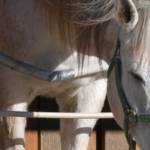When Horses Can’t or Won’t Stand Up

It’s a survival instinct: most horses that are lying down will stand up if they are closely approached, whether they’re in a stall or in the pasture. Being a prey animal rather than a predator, running away is the horse’s first line of defense, and having to get up and then run takes more time than already being in a standing position when danger threatens.
Because they are able to catnap while standing up, healthy horses don’t spend a lot of time lying down. Owners need to suspect some sort of health problem if a horse doesn’t seem to be trapped by walls, fences, or other barriers, but can’t or won’t stand up when encouraged to do so.
Colicky horses sometimes just want to lie quietly; older, arthritic horses lie down and are reluctant to get up because the action is painful; and horses with neurologic problems may not be able to coordinate their limbs well enough to make the move to a standing position. Laminitic equines lie down because of discomfort in their hooves, and those that are in a state of extreme malnourishment or starvation lack the energy to remain standing. Regardless of the reason, a horse that can’t get on its feet presents a serious situation.
Horses that lie down for extended periods—many hours or a few days—are at increased risk for complications such as pressure sores, colic, and pneumonia. Even horses that are hoisted up and put into slings can develop pneumonia because the pressure of the sling keeps their lungs from inflating fully, allowing fluid and bacteria to accumulate. Therefore, a veterinarian should be called to examine any horse that can’t or won’t get up.
Treatment on site might make the horse comfortable enough to regain a standing position, but some gravely ill recumbent horses may need to be transported to an equine clinic for care. Even with intensive treatment, the outlook for many recumbent horses is not positive. In general, the longer they have been down, the less likely they are to recover.
In a study conducted at the University of California-Davis, researchers looked at the records of 148 horses that had been treated during a 15-year period. All the horses had become recumbent either at home or after reaching the clinic. Within this group, 119 had some type of neurologic disease and 18 had musculoskeletal problems. Only 27% of the horses survived long enough to be discharged from the clinic. Horses that went down because of musculoskeletal problems had a better chance of survival than those with neurologic problems or other illnesses. Horses that had shown signs of illness for over 24 hours before collapsing were also less likely to survive.
In this study, horses that were able to stand in a sling were more likely to survive. However, using a sling to help sick horses stay upright isn’t always the best practice. Some horses panic in a sling, thrashing and jumping violently and becoming a danger to themselves and their handlers. Others simply sag into the sling, allowing it to take their entire weight and thus compromising lung function. Those most likely to be helped by slinging are the horses that calmly accept the sling and use it for balance and light pressure while they support most of their weight on their own legs.








